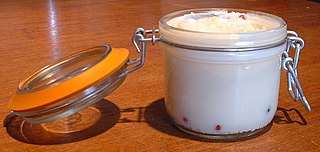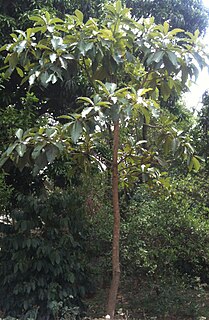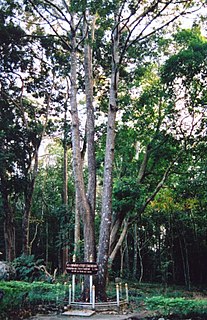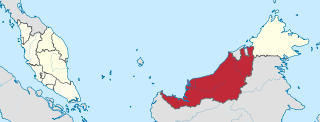
The almond is a species of tree native to Mediterranean climate regions of the Middle East and Southern Asia. Almond is also the name of the edible and widely cultivated seed of this tree. Within the genus Prunus, it is classified with the peach in the subgenus Amygdalus, distinguished from the other subgenera by corrugations on the shell (endocarp) surrounding the seed.

The cashew tree is a tropical evergreen tree that produces the cashew seed (nut) and the cashew apple. It can grow as high as 14 m (46 ft), but the dwarf cashew, growing up to 6 m (20 ft), has proved more profitable, with earlier maturity and higher yields.

The kola nut is the fruit of the kola tree, a genus (Cola) of trees that are native to the tropical rainforests of Africa. The caffeine-containing fruit of the tree is used as a flavoring ingredient in beverages, and is the origin of the term "cola".

Tallow is a rendered form of beef or mutton fat, and is primarily made up of triglycerides. It is solid at room temperature. Unlike suet, tallow can be stored for extended periods without the need for refrigeration to prevent decomposition, provided it is kept in an airtight container to prevent oxidation.

A nut is a fruit composed of an inedible hard shell and a seed, which is generally edible. In general usage, a wide variety of dried seeds are called nuts, but in a botanical context "nut" implies that the shell does not open to release the seed (indehiscent). The translation of "nut" in certain languages frequently requires paraphrases, as the word is ambiguous.

A juicer, also known as juice extractor, is a tool used to extract juice from fruits, herbs, leafy greens and other types of vegetables in a process called juicing. It crushes, grinds, and/or squeezes the juice out of the pulp.

Shea butter is a fat extracted from the nut of the African shea tree. It is usually ivory in color when raw, with more processed versions being white in color. It can be yellow when a root is added to it. It is widely used in cosmetics as a moisturizer, salve or lotion. Shea butter is edible and is used in food preparation in some African countries. Occasionally, shea butter is mixed with other oils as a substitute for cocoa butter, although the taste is noticeably different.

Canarium is a genus of about 100 species of tropical and subtropical trees, in the family Burseraceae. They grow naturally across tropical Africa, south and southeast Asia, Indochina, Malesia, Australia and western Pacific Islands; including from southern Nigeria east to Madagascar, Mauritius, Sri Lanka and India; from Burma, Malaysia and Thailand through the Malay Peninsula and Vietnam to south China, Taiwan and the Philippines; through Borneo, Indonesia, Timor and New Guinea, through to the Solomon Islands, New Caledonia, Fiji, Samoa, Tonga and Palau.

Olive oil extraction is the process of extracting the oil present in olive drupes, known as olive oil. Olive oil is produced in the mesocarp cells, and stored in a particular type of vacuole called a lipo vacuole, i.e., every cell contains a tiny olive oil droplet. Olive oil extraction is the process of separating the oil from the other fruit contents. It is possible to attain this separation by physical means alone, i.e., oil and water do not mix, so they are relatively easy to separate. This contrasts with other oils that are extracted with chemical solvents, generally hexane. The first operation when extracting olive oil is washing the olives, to reduce the presence of contaminants, especially soil which can create a particular flavor effect called "soil taste".

Mauritia flexuosa, known as the moriche palm, ité palm, ita, buriti, muriti, canangucho (Colombia), or aguaje (Peru), is a palm tree. It grows in and near swamps and other wet areas in tropical South America. It has been reported from Trinidad, Colombia, Venezuela, Guyana, Suriname, French Guiana, Brazil, Ecuador, Peru, and Bolivia.

Canarium ovatum, commonly known as pili, is a species of tropical tree belonging to the genus Canarium. It is one of approximately 600 species in the family Burseraceae. Pili are native to maritime Southeast Asia, Papua New Guinea, and Northern Australia. They are commercially cultivated in the Philippines for their edible nuts.
Pine nut oil, also called pine seed oil or cedar nut oil, is a vegetable oil, extracted from the edible seeds of several species of pine. While the oil produced from the seeds of more common European and American pine varieties is mostly used for culinary purposes, Siberian pines, as well as Korean pines yield the seeds with the highest content of pinolenic acid, as well as antioxidants associated with medicinal uses.

Pistachio oil is a pressed oil, extracted from the fruit of Pistacia vera, the pistachio nut.
A firelog is a manufactured log constructed to be used as wood fuel. Firelogs are designed to be inexpensive, while being easier to ignite, and burn longer, and more efficiently than firewood. Firelogs are traditionally manufactured using two methods. The first uses only compressed sawdust and the second uses sawdust and paraffin, which is mixed and extruded into a log shape. The extruded firelogs are individually wrapped in paper packaging which can be ignited to start burning the firelog as the paraffin is readily combustible.
Illipe butter is a vegetable fat from the nut of the Shorea stenoptera tree, sometimes used as a butter substitute. Borneo tallow nut oil is extracted from this species. The word Illipe is derived from the Tamil word for the tree Iluppai (இலுப்பை). The true illipe nut is from the species Madhuca latifolia; it is used for producing biodiesel, and Mowrah Butter is from Madhuca longifolia, Family Sapotaceae.
Vateria indica oil is extracted from the seeds of the Vateria indica plant, a species in the Dipterocarpaceae family. The Vateria indica plant is indigenous to the Western Ghats, Kerala and Tamil Nadu regions of India. It thrives in the evergreen forests, surviving up to 800 meters above sea level. Oil from the seeds of the plant is extracted through a chemical refining process which makes the plant edible.

Phulwara oil is extracted from seeds of Phulwara tree. Phulwara Trees are also known locally as Chiuri Trees, Kaeleb Trees, or Butter Nut Trees. Refined Phulwara Oil is marketed as Phulwara Ghee.















